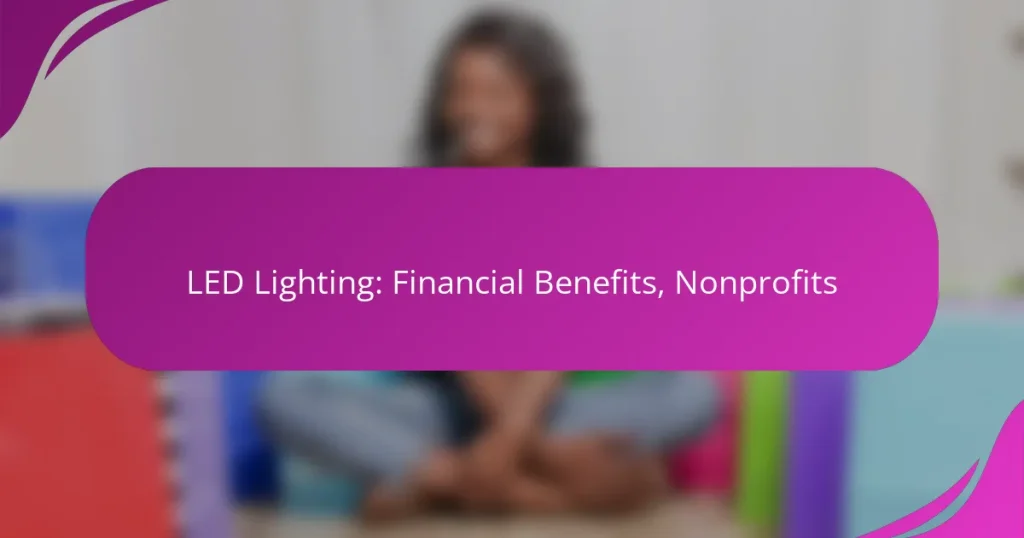LED lighting offers substantial financial advantages for nonprofits in the UK by lowering operational costs and improving funding opportunities. By embracing energy-efficient lighting solutions, these organizations can redirect savings towards their core missions and community initiatives, ultimately enhancing their impact.

How can LED lighting benefit nonprofits in the UK?
LED lighting can significantly benefit nonprofits in the UK by reducing operational costs and enhancing funding opportunities. By adopting energy-efficient lighting, these organizations can allocate more resources towards their core missions and community initiatives.
Reduced energy costs
One of the primary financial benefits of LED lighting for nonprofits is the reduction in energy costs. LEDs consume significantly less electricity compared to traditional lighting, often resulting in savings of 50% or more on energy bills. This reduction allows nonprofits to redirect funds towards programs and services that directly impact their communities.
Additionally, many local authorities in the UK offer grants or incentives for organizations that switch to energy-efficient lighting. Nonprofits should research available funding options to maximize their savings when transitioning to LED technology.
Increased funding opportunities
Switching to LED lighting can open up new funding opportunities for nonprofits. Many grant-making bodies prioritize sustainability and energy efficiency in their funding criteria. By demonstrating a commitment to reducing energy consumption, nonprofits can enhance their appeal to potential donors and grantors.
Furthermore, some corporate sponsors may be more willing to partner with organizations that adopt environmentally friendly practices. This alignment can lead to increased financial support and collaborative projects that benefit both parties.
Enhanced community engagement
Implementing LED lighting can enhance community engagement by showcasing a nonprofit’s commitment to sustainability. This initiative can attract attention from local media and community members, fostering a positive public image. Nonprofits can leverage this visibility to engage volunteers and supporters who share similar values.
Moreover, hosting events or workshops focused on energy efficiency can further involve the community. By educating the public about the benefits of LED lighting, nonprofits can strengthen their relationships with stakeholders and encourage community participation in their initiatives.
Improved sustainability image
Adopting LED lighting contributes to a nonprofit’s sustainability image, which is increasingly important in today’s environmentally conscious society. By reducing their carbon footprint, organizations can position themselves as leaders in sustainability, attracting environmentally minded supporters and partners.
Nonprofits can communicate their commitment to sustainability through marketing materials and social media. Highlighting the switch to LED lighting not only demonstrates responsible resource management but also aligns with the values of many potential donors and volunteers.
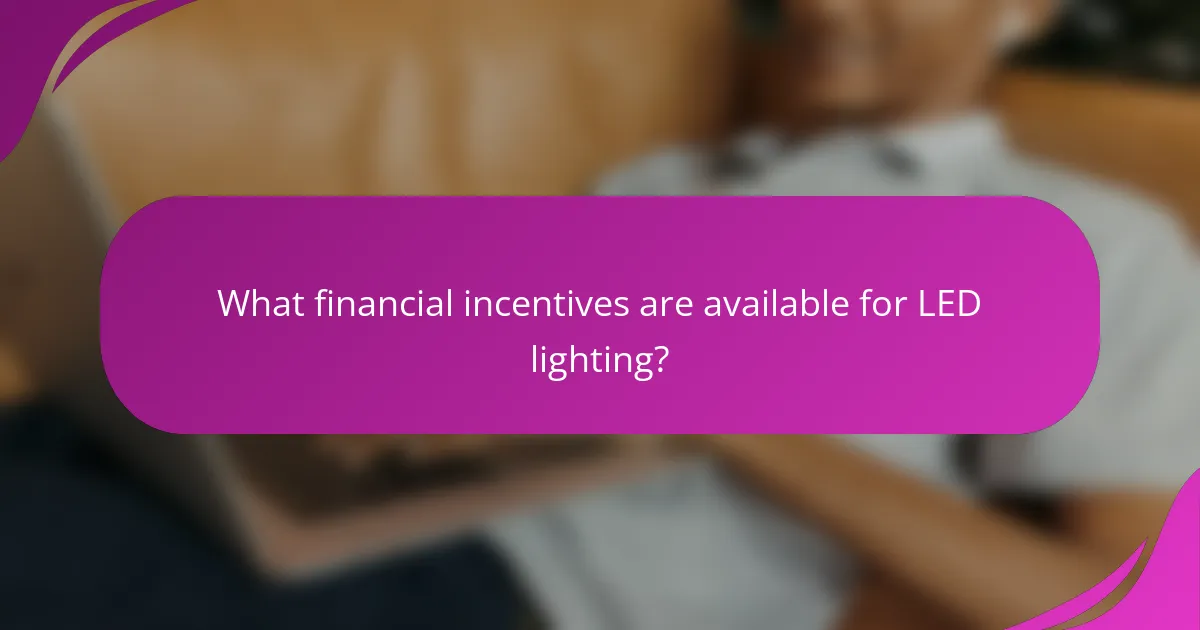
What financial incentives are available for LED lighting?
Various financial incentives exist for LED lighting, including government grants, tax relief programs, and utility rebates. These incentives can significantly reduce the upfront costs associated with upgrading to energy-efficient lighting solutions.
Government grants
Government grants for LED lighting are often available through federal, state, or local programs aimed at promoting energy efficiency. These grants can cover a portion of the installation costs, making it easier for nonprofits to transition to LED lighting.
To access these grants, organizations typically need to submit an application detailing the project scope and expected energy savings. It’s essential to research eligibility requirements and deadlines for each program.
Tax relief programs
Tax relief programs can provide significant savings for nonprofits investing in LED lighting. These programs may include tax credits or deductions that lower the overall tax burden, effectively offsetting some of the costs associated with the upgrade.
Nonprofits should consult with a tax professional to understand the specific benefits available in their region and ensure compliance with any necessary documentation or reporting requirements.
Utility rebates
Utility companies often offer rebates for customers who upgrade to energy-efficient LED lighting. These rebates can vary widely based on the utility provider and the specific lighting products used, sometimes covering a substantial percentage of the installation costs.
To take advantage of utility rebates, nonprofits should check with their local utility providers for available programs and application processes. Keeping all receipts and documentation is crucial for a smooth rebate claim process.
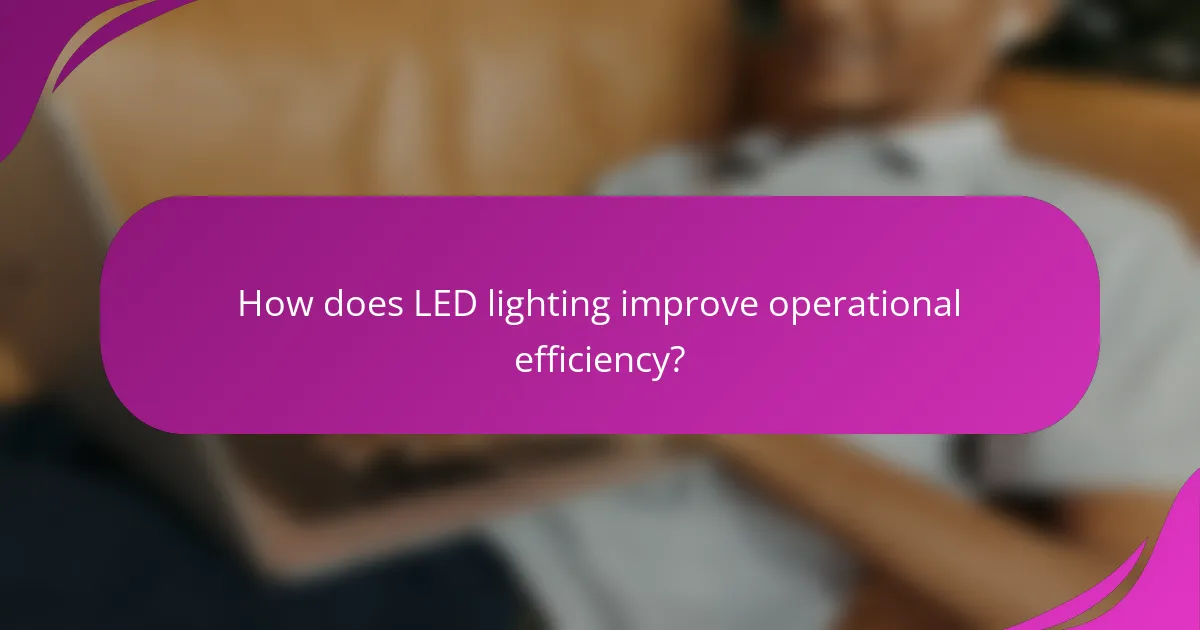
How does LED lighting improve operational efficiency?
LED lighting enhances operational efficiency by reducing energy consumption and lowering overall costs. Nonprofits can benefit significantly from these savings, allowing more funds to be allocated to their core missions.
Lower maintenance costs
LED lights require less frequent replacement compared to traditional lighting options, which translates to lower maintenance costs. This is particularly beneficial for nonprofits that often operate on tight budgets, as reduced maintenance means fewer labor hours and less downtime.
Additionally, many LED fixtures are designed to be more durable and resistant to damage, further decreasing the need for repairs or replacements. By investing in LED technology, organizations can streamline their operations and focus resources on their primary objectives.
Longer lifespan compared to traditional lighting
LED lighting typically lasts significantly longer than conventional bulbs, often exceeding 25,000 hours of use. This extended lifespan means that nonprofits can enjoy years of reliable lighting without the hassle of frequent replacements.
The longevity of LED lights not only reduces costs associated with purchasing new bulbs but also minimizes the environmental impact of disposal. By choosing LEDs, organizations contribute to sustainability efforts while ensuring their facilities remain well-lit and functional.
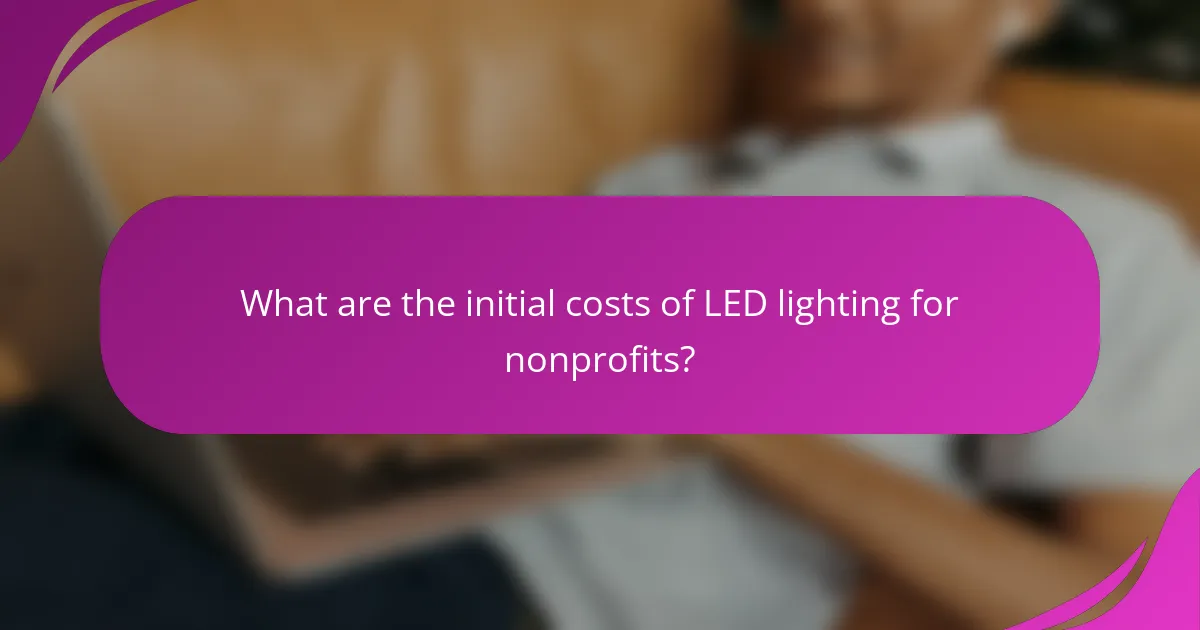
What are the initial costs of LED lighting for nonprofits?
The initial costs of LED lighting for nonprofits can vary significantly based on the scale of the installation and specific lighting needs. Generally, these costs include purchasing the LED fixtures and installation expenses, which can be offset by long-term savings on energy bills.
Average installation costs
The average installation costs for LED lighting in nonprofit organizations typically range from a few hundred to several thousand dollars, depending on the size of the facility and the number of fixtures required. For smaller nonprofits, costs may start around $1,000, while larger organizations could see expenses exceeding $10,000.
It’s essential to consider additional factors such as labor costs, which can vary by region. Nonprofits may also explore grants or funding opportunities to help cover these initial expenses.
Cost comparison with traditional lighting
When comparing LED lighting to traditional lighting options like incandescent or fluorescent bulbs, the savings become evident. LED lights generally consume about 75% less energy than incandescent bulbs and last significantly longer, often exceeding 25,000 hours compared to just 1,000 hours for incandescent options.
While the upfront costs for LED lighting can be higher, the long-term savings on energy bills and reduced maintenance costs make them a more economical choice over time. Nonprofits should calculate the return on investment (ROI) to determine the financial benefits specific to their situation.
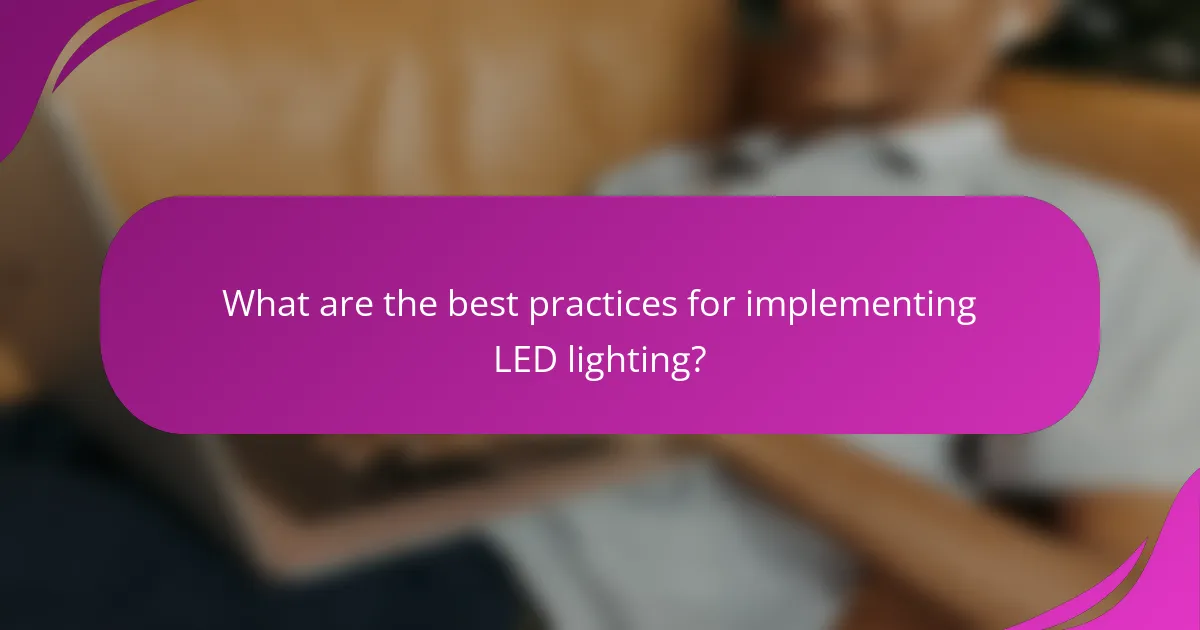
What are the best practices for implementing LED lighting?
Implementing LED lighting effectively involves several best practices that can enhance energy efficiency and reduce costs. Key steps include conducting an energy audit, selecting appropriate LED products, and engaging stakeholders throughout the process.
Conducting an energy audit
An energy audit is essential for understanding current energy usage and identifying areas for improvement. This process typically involves assessing existing lighting systems, measuring energy consumption, and evaluating the potential savings from switching to LED technology.
During the audit, consider factors such as the type of lighting currently in use, the hours of operation, and the specific needs of different spaces. This information will help prioritize which areas to upgrade first for maximum impact.
Choosing the right LED products
Selecting the right LED products is crucial for achieving the desired lighting quality and energy savings. Look for LEDs that meet recognized standards, such as ENERGY STAR, which ensures efficiency and performance.
Consider factors like color temperature, lumens per watt, and the intended application when choosing LEDs. For example, warmer color temperatures are often preferred in communal areas, while cooler temperatures may be suitable for workspaces.
Engaging stakeholders in the decision
Involving stakeholders in the LED lighting decision-making process can lead to better outcomes and smoother implementation. Engage staff, board members, and facility managers to gather input on lighting needs and preferences.
Communicate the benefits of LED lighting, such as reduced energy costs and improved lighting quality, to gain buy-in. Hosting informational sessions or workshops can also help address concerns and foster a collaborative approach to the transition.
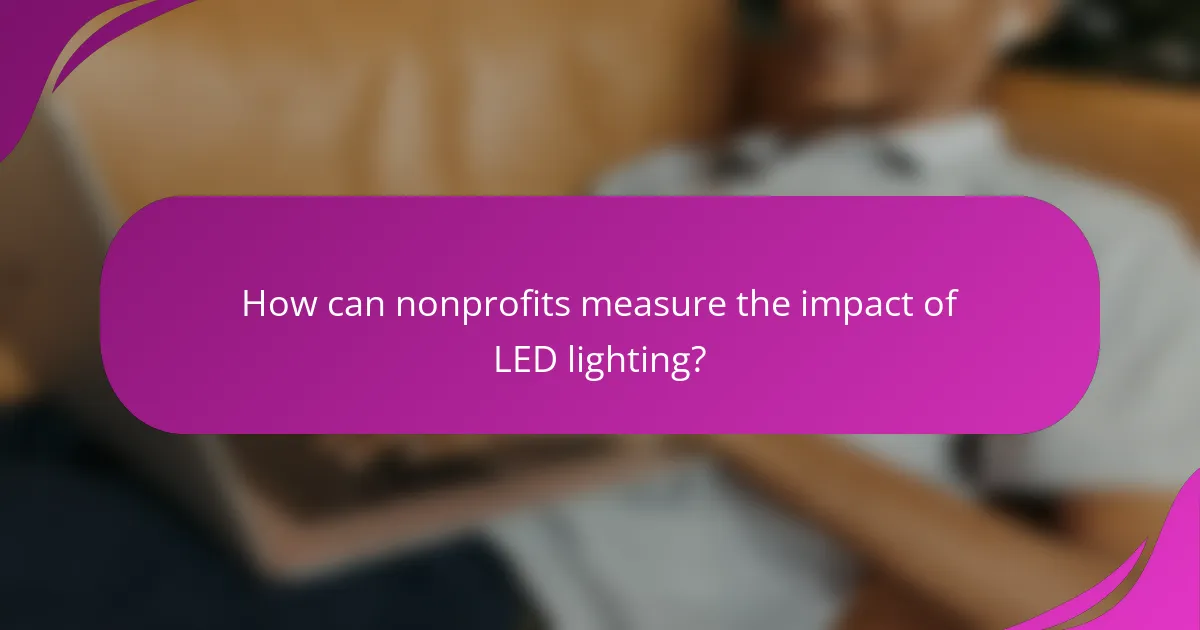
How can nonprofits measure the impact of LED lighting?
Nonprofits can measure the impact of LED lighting by tracking energy savings and assessing community feedback. These methods provide tangible data and insights that help organizations understand the benefits of their lighting upgrades.
Tracking energy savings
To effectively track energy savings from LED lighting, nonprofits should compare their electricity bills before and after the installation. This can involve calculating the kilowatt-hour (kWh) savings and translating that into cost savings, typically seen as a reduction of 30-70% in energy consumption.
Using energy monitoring tools can provide real-time data on usage, helping organizations identify patterns and further optimize their lighting systems. Regular audits can also ensure that the expected savings align with actual performance.
Assessing community feedback
Gathering feedback from the community is crucial for understanding the qualitative impact of LED lighting. Nonprofits can conduct surveys or hold focus groups to gauge public perception regarding the brightness, safety, and aesthetic appeal of the new lighting.
Additionally, tracking community engagement metrics, such as increased foot traffic or participation in events held in well-lit areas, can provide valuable insights. This feedback can help nonprofits refine their lighting strategies and enhance community relations.

What are the long-term benefits of LED lighting?
LED lighting offers significant long-term benefits, primarily through reduced energy consumption and lower maintenance costs. These advantages lead to substantial financial savings for organizations, especially nonprofits that often operate on tight budgets.
Continued cost savings
One of the most compelling benefits of LED lighting is its ability to generate ongoing cost savings. LEDs consume considerably less energy compared to traditional incandescent or fluorescent bulbs, often reducing energy bills by up to 75%. This reduction in energy use translates into lower operational costs over time.
Additionally, LED lights have a longer lifespan, typically lasting 15,000 to 50,000 hours. This longevity means fewer replacements and lower maintenance expenses, which is particularly beneficial for nonprofits that may lack the resources for frequent upkeep. For example, switching to LED lighting can save a nonprofit thousands of dollars annually in both energy and replacement costs.
To maximize these savings, nonprofits should consider conducting an energy audit to assess current lighting usage and identify potential areas for improvement. Investing in LED technology not only enhances financial efficiency but also aligns with sustainability goals, making it a smart choice for organizations focused on social responsibility.
